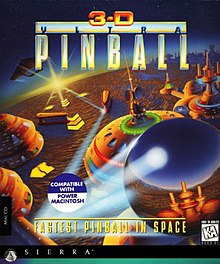| 3-D Ultra Pinball | |
|---|---|
 | |
| Developer(s) | Dynamix |
| Publisher(s) | Sierra On-Line |
| Series | 3-D Ultra Pinball |
| Platform(s) |
Microsoft Windows Macintosh |
| Release | October 25, 1995 |
| Genre(s) | Action |
| Mode(s) | Single-player |
3-D Ultra Pinball is video game released in 1995, and is the first game in 3-D Ultra Pinball video game series.
Gameplay
The original 3-D Ultra Pinball game was released in 1995. This game is based on the space simulation game Outpost. There are three tables named "Colony", "Command Post", and "Mine". Each table holds a set of five challenges. Smaller "mini-tables" are featured with their own set of flippers. The goal is to build and launch a starship, completing the game's entire course.
Reception
Reviewing the Macintosh version, a Next Generation critic commented that "there is some substance to the argument that pinball is not a game meant for the monitor, but 3-D Ultra Pinball works, and it works very well". He particularly praised the fact that the graphics and physics both include elements not possible on a real pinball table, while remaining "true to the pinball spirit". Despite this, he gave it only two out of five stars. [1] It received a score of 3.5 out of 5 from MacUser. [2]
According to market research firm PC Data, 3-D Ultra Pinball was the 18th-best-selling computer game in the United States for the year 1996. [3] According to Sierra On-Line, its sales surpassed 250,000 copies by the end of March 1996. [4]
Development
A port on the Sega Saturn was planned, but it was cancelled for unknown reasons. [5]
Reviews
- PC Gamer (December 1995)
References
- ^ "3-D Ultra Pinball". Next Generation. No. 13. Imagine Media. January 1996. p. 168.
- ^ LeVitus, Bob (June 1996). "The Game Room". MacUser. Archived from the original on 1999-02-25. Retrieved 2018-09-24.
- ^ Staff (February 26, 1997). "1996 PC Best Sellers". Next Generation. Archived from the original on 1997-06-06. Retrieved 2018-09-24.
- ^ Sierra On-Line Form 10-K (Report). Bellevue, Washington. March 31, 1996. pp. 7–9. Archived from the original on April 16, 2018.
- ^ "File:SSM JP 19960726 1996-12.pdf" (PDF). Sega Retro. 2021-04-03. Retrieved 2021-04-03.